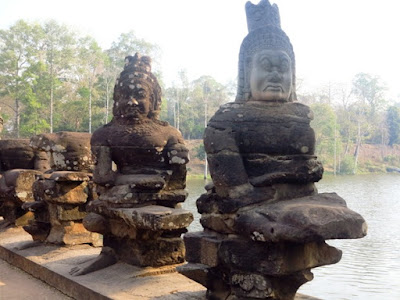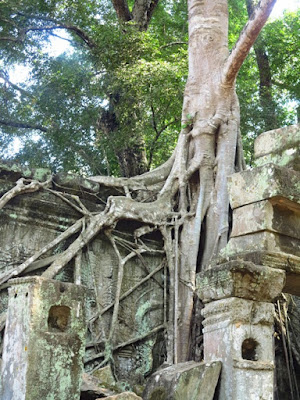As mentioned in an earlier post, there are thousands
of temples in the Angkor region with Angkor Wat being the most readily
recognizable. During the Golden Age of the Angkor civilization, the 9th to
15th centuries, this southeast Asia country was twice as large and much more
prosperous than it is today.
 |
| Buddha statues adorn temple entrances |
Angkor
Thom—the happy place
While in Siem Reap, Cambodia, we also visited AngkorThom, a striking temple complex known for sculptures, carved Buddhas, and tall
structures. Unlike Angkor Wat, Angkor Thom was a large city--the last capital of the 12th century Khmer civilization--where people lived
vibrant, active lives. Hospitals, roads, water reservoirs, and a detailed
infrastructure were constructed during the period of high prosperity.
The Bayon Temple in the center of the temple city,
is known for its many carved Buddhas with smiling faces—reflecting good times
in Cambodia. Now we see only ruins, a skeleton of the historical city that fell
when invaded by the Siamese (who looted all the gold and treasures). Later the
Burmese invaded Siam and took those same treasured items.
Entrance to Angkor Thom, also a UNESCO site, is
through a very elegantly carved gate. Cars, motorcycles, and foot traffic stream
through this ornate gate into the complex. You’ll enjoy the smiling faces of rugged
Buddha statues while imagining a pleasant daily life for the many inhabitants
in those ancient times.  |
| Smiling Buddhas reflect prosperous times in Cambodia. |
Roaming monkeys were familiar sights as we explored massive structures and carvings on stone walls, including at the Elephant Terrace.
Jungle Temple--a wild place
When life circumstances deteriorated and people left Ta Prohm Temple,
the jungle took over and destroyed many of the structures. Huge trees are now
entwined in, through, and around walls of the so-called Jungle Temple. Tree
roots tangle around rocks and stones, woven into the fabric of the
deteriorating structures. They have become inseparable—one would fall without
the other.
 |
| Enormous tree roots have wound their way around remains of this temple. |
 |
| Roots and stones entwined in an inseparable structure. |
 |
| It's had to imagine how imposing the roots have become through the ensuing centuries. |
Photos by Larry and Beverly Burmeier
Find out more things to do in Cambodia at https://www.jenreviews.com/best-things-to-do-in-cambodia/
.











No comments:
Post a Comment